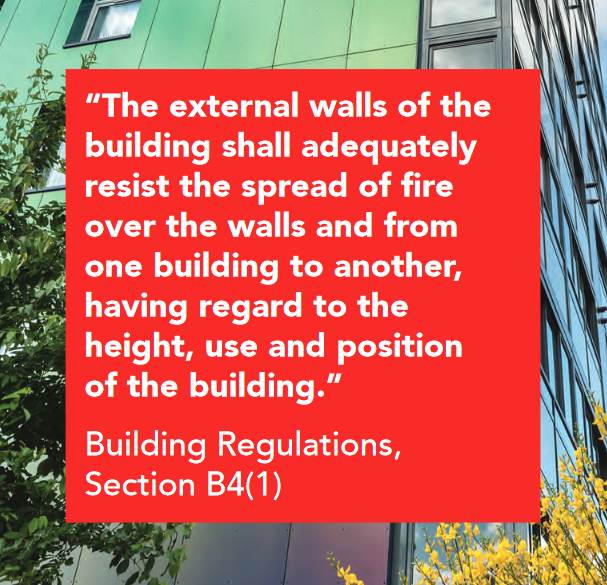
High Rise Buildings with a Floor Level Above 18m
It's the Law!
The Requirement B4(1) of the Building Regulations states that, “The external walls of the building shall adequately resist the spread of fire over the walls and from one building to another, having regard to the height, use and position of the building.”
This article by ICM's Director of Education and Training David Jones builds upon his previous articles and is provided to further assist all those who really must be competent in understanding what is needed for having regard to whatever has to be designed to ensure the buildings are fire safe!
David Jones is able to call upon own personal hands-on design experience when he was commissioned by Croydon LB back in 1998 to design overcladding solutions to their high rise residential tower blocks ... all of those Croydon HRRBs passed the Fire Test and assessment undertaken by the BRE post-Grenfell ~ David Jones comments "whilst I am personally proud of the achievement to have designed and specified successful design solutions I am sad angry and certainly not proud that standards and competence in parts of my construction sector has fallen to a new low!"
So, let's consider the external wall system of a high rise, multi-unit buildings - there are many potential prime sources of ignition which can allow fire to attack the cladding:
■ Flames issuing out of windows
■ Fire radiation from adjacent buildings
■ Ignition through arson
... and, Phase 1 of the ongoing Grenfell Inquiry which was the hearing of evidence as to cause which has now ended - in his closing comments Michael Mansfield QC made reference to the cause of the sad fire was a faulty domestic appliance in one of the flats ... Mansfield QC made the point that it is inevitable there will be such faults in electrical equipment and, for which, it is impossible to know where and when ...
A competent designer having proven skills, knowledge and appropriate experience would culturally know and understand the use of non-combustible materials within the external wall system can limit the spread of fire and the risk of secondary compartment fires in other parts of the building.
Regulation 7 of the Building Regulations deals with materials and workmanship and states:
7 Materials and workmanship
Building work shall be carried out
(a) with adequate and proper materials which:
Are appropriate for the circumstances in which they are used
Are adequately mixed or prepared
Are applied, used or fixed so as adequately to perform the functions for which they are designed
(b) in a workmanlike manner.
to which has now been added three important new paragraphs that include exemptions for certain materials such as seals and gaskets, which are set out in the new paragraph 3, below.
The new paragraph (2) says:
(2) Subject to paragraph (3), building work shall be carried out so that materials which become part of an external wall, or specified attachment, of a relevant building are of European Classification A2-s1, d0 or A1, classified in accordance with BS EN 13501-1:2007+A1:2009 entitled ‘Fire classification of construction products and building elements. Classification using test data from reaction to fire tests” (ISBN 978 0 580 59861 6) published by the British Standards Institution on 30th March 2007 and amended in November 2009.
David Jones points out that the only recognised classification is the European classification. The older British Standard classification, which was recognised in previous guidance, is not now included in the new regulation. David Jones also reminds that 'guidance' is not the law nor does it prescriptively guide designers to solutions that are safe in all circumstances and situations.
BS EN 13501-1 defines the classes A1 and A2 as follows:
Class A1 Will not contribute in any stage of the fire, including the fully developed fire
Class A2 Will not significantly contribute to the fire load and fire growth in a fully developed fire
The characteristics “s” and “d” are defined as follows:
s1 = Weak or no smoke
s2 = Medium smoke
s3 = High smoke
d0 = No dripping at all
d1 = Slow dripping recorded
d2 = High dripping recorded
“Relevant” buildings over 18m must be constructed or refurbished using only materials in the external wall which meet the limited combustibility requirement of A2-s1, d0 * or better which is currently referred to in terms of a 'new ban'.
Relevant buildings are defined below in new paragraph (4) of the Regulation.
The guidance in Approved Document B for any other building over 18m states that materials in the external wall should meet the limited combustibility requirement of A2-s3, d2 or better.
The new paragraph (3) details those components that are exempt from the ban, which applies to the entire external wall construction, and not just the cladding.
(3) Paragraph (2) does not apply to:
(a) cavity trays when used between two leaves of masonry;
(b) any part of a roof (other than any part of a roof which falls within paragraph (iv) of regulation 2(6)) if that part is connected to an external wall;
(c) door frames and doors;
(d) electrical installations;
(e) insulation and waterproofing materials used below ground level;
(f) intumescent and fire stopping materials where the inclusion of the materials is necessary to meet the requirements of Part B of Schedule 1;
(g) membranes;
(h) seals, gaskets, fixings, sealants and backer rods;
(i) thermal break materials where necessary to prevent thermal bridging in order to meet the requirements of Part L of Schedule 1; or
(j) window frames and glass.
and new paragraph (4) then sets out where these new restrictions apply:
(4) In this regulation:
(a) a “relevant building” means a building with a storey (not including roof-top plant areas or any storey consisting exclusively of plant rooms) at least 18 metres above ground level and which—
► contains one or more dwellings;
► contains an institution; or
► contains a room for residential purposes but does not include a room in a hostel, hotel or boarding house; and
(b) ‘above ground level’ in relation to a storey means above ground level when measured from the lowest ground level adjoining the outside of a building to the top of the floor surface of the storey.
So, new regulation 7(2) applies to any building with a storey at least 18m above ground level containing one or more dwellings. By including institutions (which are defined in Regulation 2) it also covers some residential schools, care homes and hospitals, sheltered accommodation, student residences or other institutional accommodation blocks. The final group includes any building that contains ‘a room for residential purposes’.
Hostels, hotels or boarding houses are excluded, unless they are converted into residential accommodation, such as student housing.
David Jones takes a personal view on the current exclusion on hostels, hotel and boarding houses - "I do not apply the exclusion - by applying good sense and basics of competent risk management it is difficult, if not impossible, to differentiate between trusting residents asleep irrespective of use class!"
There are additional amendments in Regulation 2, relating to the definition of an external wall and a ‘specified attachment’, in the definition of material change of use in Regulation 5 to refer to new Regulation 7(4)(a), and in Regulation 6 to mirror the new Regulation 7(2).
The material change-of-use requirement is very important, because it means that – for example – a hotel may be built using materials not permitted in a student residence, but the hotel cannot then be converted to a student residence without replacing any non-compliant materials.
This means that owners or developers will need to think hard about the materials used in taller buildings that are not covered by Regulation 7(4)(a)(i) or (ii).
David Jones points out that expert witness Dr. Lane has been very clear in her expert viewpoint about the suitability of current certification systems ... this underlies the questions she raises in her evidence @ 11.2.25 “For the avoidance of doubt I consider an external surface formed with a composite of a polyethylene core to be unable to comply with the functional requirement of B(4)1 of the Building Regulations. I am concerned therefore about the provisions made in Diagram 40 of AD B 2013 which is statutory guidance and advise these are changed as soon as possible.”
Ambiguity and conflicts in the guidance contained in ADBv2 does render it an unsound process for anyone to place absolute reliance in that published guidance for the purpose of selecting insulation for the external envelope of a building and fully supports Michael Mansfield QC in his call for an immediate moratorium limiting "nothing less than A1 until the sector designers get a competent grip and understand the problems!" and David Jones adds " ... those who select and specify insulation products to be used in the external envelope of any residential building should possess appropriate skill, knowledge and expertise to be able to make any choice other than classified 'Non-Combustible' Class A1 "
Using non-combustible materials wherever possible is the simplest and easiest method of designing out risk and meeting the criteria of Building Regulations - the basis of the call of Michael Mansfield QC in his closing statement to the Grenfell Inquiry Phase 1 ...
An excellent publication to assist designers has been published by Rockwool to understand the approach to meeting the guidance within the Requirements of Approved Document B Volume 2 and Designing Out Risk on High Rise Buildings with a Floor Level above 18m and sets out the options for the designer and also good information on case study too ...
Ed.
